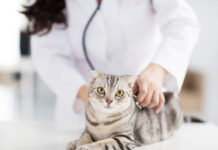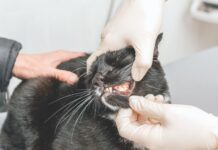My cat leaves peelings of her claws when she scratches my furniture and carpet. Is that common for cats, or should I worry? Also, when she cleans her paws, she has the tendency to pull on them. Should I try to make her stop?
Theres nothing to worry about as far as your kittys health is concerned, but Im a bit concerned about the health of your furniture and carpet. Cat claws can cause tremendous damage to such surfaces, so you should consider training her to use a scratching post. Furniture damage can be reduced by regularly trimming her claws, or you can ask your veterinarian about applying plastic nail tips to decrease scratching damage even more.
Onionlike layers
The peelings that you find lying about are the outer layers of your cats claws. The claws are formed in overlapping sheets, much like the layers of an onion, and when a cat sharpens her claws, she is simply removing the outer layers to reveal the ones beneath. Removing this outer layer of the front claws is usually accomplished when cats scratch on a rough surface, but the same can be done as they chew and pull on their claws. Chewing and pulling is the cats preferred method for grooming the rear claws.
So let her continue to pull on her claws as she grooms herself. Shes merely doing what she needs to do.
———-
My newest cat has gained an alarming amount of weight. She is almost a year old and weighs approximately 12 pounds – a weight that is not appropriate for her body size. She was spayed at about six months of age. I have four other cats and leave dry food out all the time. She seems to display a kind of possessive behavior in that she will run to the dish if she hears or sees one of the other cats eating, and then shell eat some herself. Also, she sometimes tries to block the other cats from getting to the dish. The weight gain and possessive behavior were not evident until three months after spaying. My veterinarian thinks her eating habits are the result of spaying. My other cats do not have a problem with obesity, and Im told that restricting their food intake to accommodate her issue would jeopardize their health. Any thoughts?
During a lecture on feline obesity a few years ago, one of my more portly veterinary colleagues leaned over to me and whispered, You know, Jim, the only people worried about fat cats are skinny vets! I wish that were really the case. There truly are health problems associated with obesity: Obese cats are about four times more likely to develop diabetes mellitus, about five times more likely to become lame, and about twice as likely to be afflicted with certain skin conditions than are their slimmer counterparts.
What about spaying?
A cat gains weight because its intake of calories exceeds its bodys requirements – it eats more than it burns off. A compilation of the results of several studies suggests a number of ways by which spaying encourages a gain in weight:
(1) Spaying is associated with a decrease in metabolic rate. On average, neutered cats require about one fourth to one third fewer calories.
(2) Spaying affects food intake. In several studies, spayed cats consistently ate more of the food offered than did unspayed cats; the latter appearing better able to self-regulate food consumption. Spaying may disrupt the physiologic mechanisms that inform the animal when its eaten enough (this is true in laboratory rats, and perhaps cats, too).
(3) Spaying is associated with a reduction in activity levels. Couch-potato cats burn fewer calories.
(4) Spaying changes the activity of an enzyme, lipoprotein lipase, that is involved in fat storage, resulting in enhanced storage of body fat.
However, please note that even though spaying is associated with obesity, the benefits of the procedure far outweigh any downsides.
Other factors at fault
Some researchers have linked obesity with indoor confinement, reasoning that cats with no access to the outdoors have fewer opportunities to burn calories. Others have found a relationship with the feeding of high-fat, highly palatable dry diets, and perhaps also with the carbohydrates contained therein. Still others determined that the continuous provision of food – ad libitum or free choice feeding – promotes obesity, regardless of the type of food being offered. For many spayed cats, making food available at all times just will not work, because they will overeat.
And then theres the eating behavior of each individual. Frankly some cats are … well, pigs. One of my now-departed feline friends, Fang, felt compelled to eat whenever anyone entered the room where her food dish was kept. And if one of the other cats approached the dish, she always pushed in first. So in some cases, competition for food is a factor in feline overeating. This may be occurring in your household.
Resolution?
On average, a caloric reduction of about 30 percent is required to maintain optimal body condition after spaying or neutering. However, if a cat is spayed while still growing, as most are, there is a danger in markedly restricting food intake, so make sure to follow your veterinarians guidance. You probably should provide only a set amount of food – including any treats – on a daily basis. How much, you might ask? The amount varies from cat to cat, so again consult your veterinarian. If there are several cats in the household, you may need to feed them individually, lest the ones that are
obesity-inclined snatch someone elses food.



